technical data MERCEDES-BENZ C-CLASS ESTATE 2007 User Guide
[x] Cancel search | Manufacturer: MERCEDES-BENZ, Model Year: 2007, Model line: C-CLASS ESTATE, Model: MERCEDES-BENZ C-CLASS ESTATE 2007Pages: 377, PDF Size: 6.19 MB
Page 22 of 377
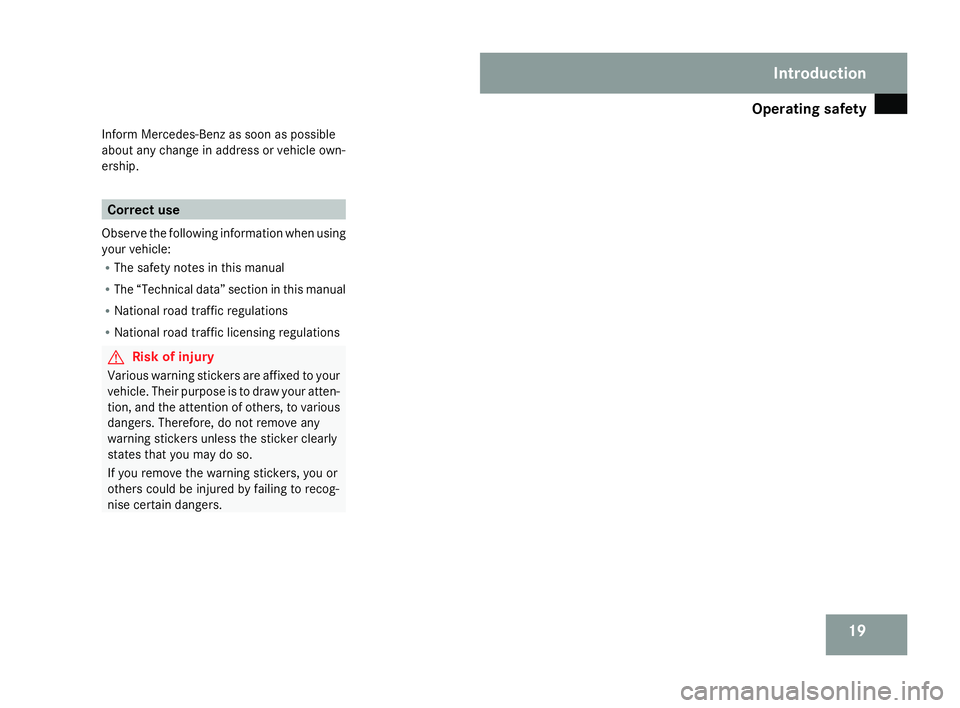
Operating safet
y 19
Inform Mercedes-Benz as soon as possible
about any change in address or vehicle own-
ership. Correct use
Observe the following information when using
your vehicle:
R The safety notes in this manual
R The “Technical data” section in this manual
R National road traffic regulations
R National road traffic licensing regulations G
Risk of injury
Various warning stickers are affixed to your
vehicle. Their purpose is to draw your atten-
tion, and the attention of others, to various
dangers. Therefore, do not remove any
warning stickers unless the sticker clearl y
states that you may do so.
If you remove the warning stickers, you or
others could be injured by failing to recog-
nise certain dangers. Introduction
204_AKB; 2; 3, en-GB
mkalafa,
2007-06-26T23:11:51+02:00 - Seite 19
Page 208 of 377
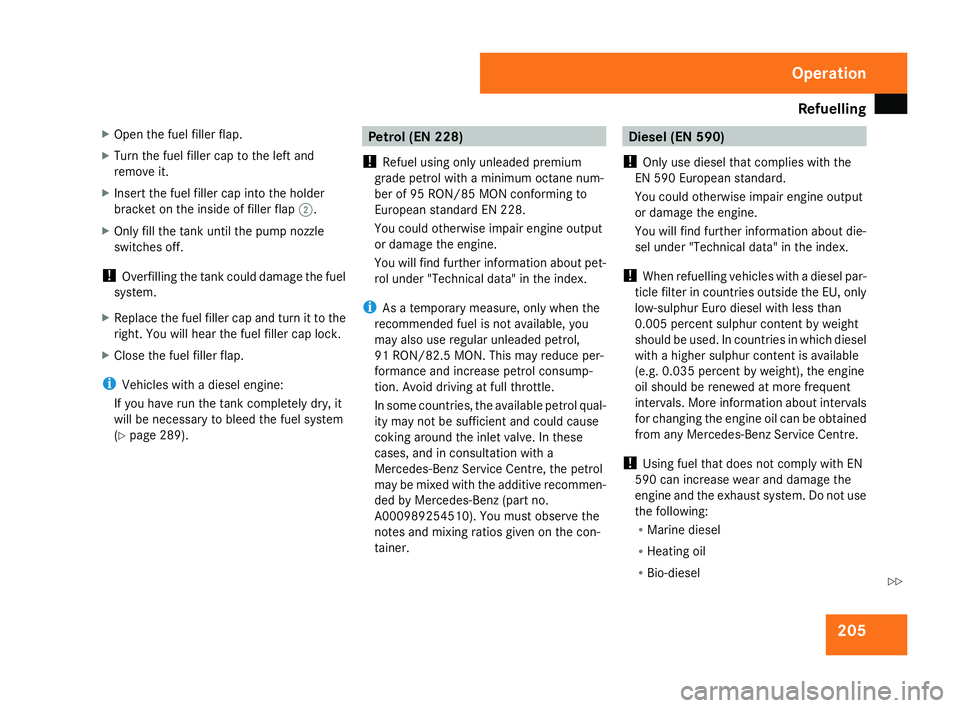
Refuelling
20
5
X
Open the fuel filler flap.
X Turn the fuel filler cap to the left and
remove it.
X Insert the fuel filler cap into the holder
bracket on the inside of filler flap 2.
X Only fill the tank until the pump nozzle
switches off.
! Overfilling the tank could damage the fuel
system.
X Replace the fuel filler cap and turn it to th e
right. You will hear the fuel filler cap lock.
X Close the fuel filler flap.
i Vehicles with a diesel engine:
If you have run the tank completely dry, it
will be necessary to bleed the fuel system
( Y page 289). Petrol (EN 228)
! Refuel using only unleaded premium
grade petrol with a minimum octane num-
ber of 95 RON/85 MON conforming to
European standard EN 228 .
You could otherwise impair engine output
or damage the engine.
You will find further information about pet-
rol under "Technical data" in the index .
i As a temporary measure, only when the
recommended fuel is not available, yo u
may also use regular unleaded petrol,
91 RON/82.5 MON. This may reduce per-
formance and increase petrol consump-
tion. Avoid driving at full throttle.
In some countries, the available petrol qual-
ity may not be sufficient and could caus e
coking around the inlet valve. In thes e
cases, and in consultation with a
Mercedes-Benz Service Centre, the petrol
may be mixed with the additive recommen-
ded by Mercedes-Benz (part no.
A000989254510). You must observe the
notes and mixing ratios given on the con -
tainer. Diesel (EN 590)
! Only use diesel that complies with the
EN 590 European standard.
You could otherwise impair engine outpu t
or damage the engine.
You will find further information about die-
sel under "Technical data" in the index.
! When refuelling vehicles with a diesel par-
ticle filter in countries outside the EU, only
low-sulphur Euro diesel with less than
0.005 percent sulphur content by weight
should be used. In countries in which diesel
with a higher sulphur content is available
(e.g. 0.035 percent by weight), the engine
oil should be renewed at more frequent
intervals. More information about intervals
for changing the engine oil can be obtained
from any Mercedes-Benz Service Centre.
! Using fuel that does not comply with EN
590 can increase wear and damage the
engine and the exhaust system. Do not use
the following:
R Marine diesel
R Heating oil
R Bio-diesel Operation
204_AKB; 2; 3, en-G
B
mkalafa , 2007-06-26T23:11:51+02:00 - Seite 205 Z
Page 211 of 377
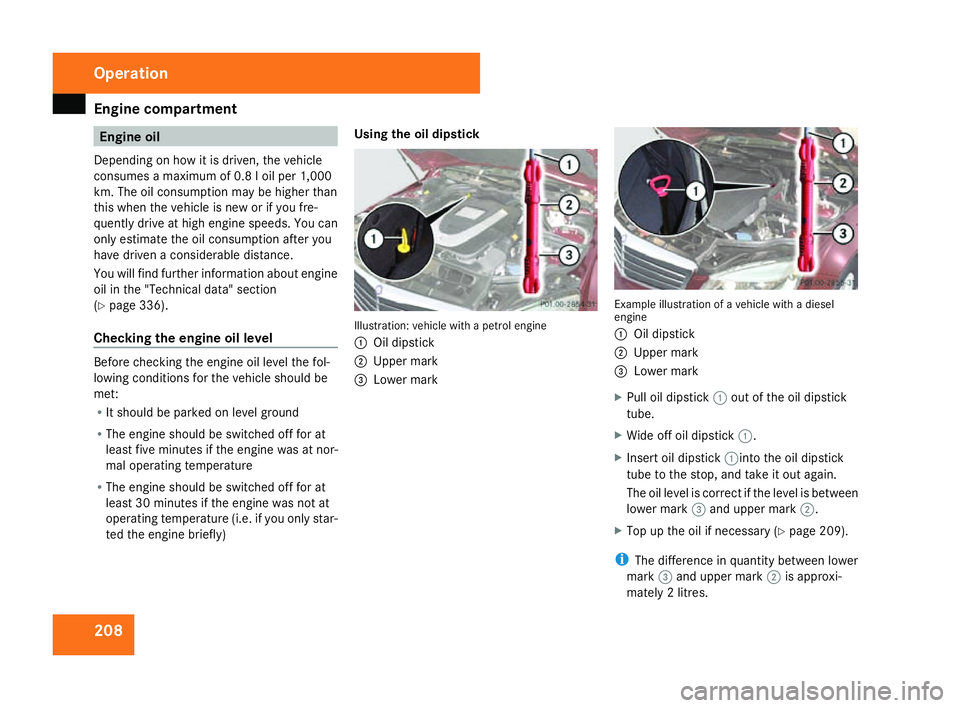
Engine compartment
208 Engine oil
Depending on how it is driven, the vehicl e
consumes a maximum of 0.8 l oil per 1,000
km. The oil consumption may be higher than
this when the vehicle is new or if you fre-
quently drive at high engine speeds. You can
only estimate the oil consumption after yo u
have driven a considerable distance.
You will find further information about engine
oil in the "Technical data" section
( Y page 336).
Checking the engine oil level Before checking the engine oil level the fol-
lowing conditions for the vehicle should be
met:
R
It should be parked on level ground
R The engine should be switched off for at
least five minutes if the engine was at nor-
mal operating temperature
R The engine should be switched off for at
least 30 minutes if the engine was not at
operating temperature (i.e. if you only star-
ted the engine briefly) Using the oil dipstick
Illustration: vehicle with a petrol engine
1
Oil dipstick
2 Upper mark
3 Lower mark Example illustration of a vehicle with a diese
l
engine
1 Oil dipstick
2 Upper mark
3 Lower mark
X Pull oil dipstick 1out of the oil dipstick
tube.
X Wide off oil dipstick 1.
X Insert oil dipstick 1into the oil dipstick
tube to the stop, and take it out again.
The oil level is correct if the level is between
lower mark 3and upper mark 2.
X Top up the oil if necessary (Y page 209).
i The difference in quantity between lower
mark 3and upper mark 2is approxi-
mately 2 litres. Operation
204_AKB; 2; 3, en-GB
mkalafa,
2007-06-26T23:11:51+02:00 - Seite 208
Page 213 of 377
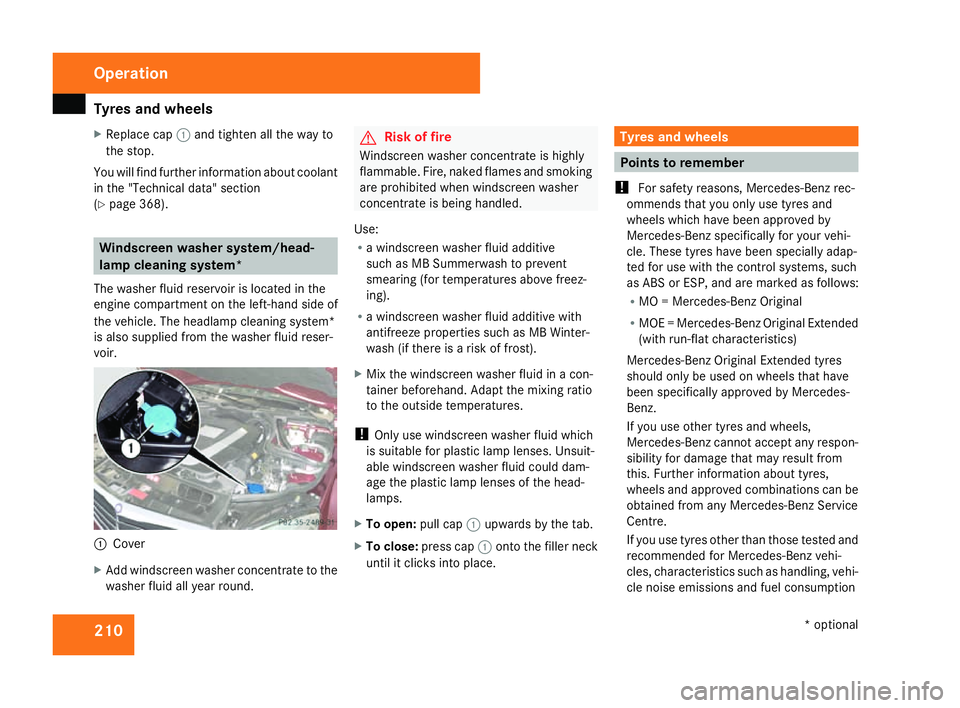
Tyres and wheels
21
0
X
Replace cap 1and tighten all the way to
the stop.
You will find further information about coolan t
in the "Technical data" section
( Y page 368). Windscreen washer system/head-
lamp cleaning system
*
The washer fluid reservoir is located in the
engine compartment on the left-hand side of
the vehicle. The headlamp cleaning system*
is also supplied from the washer fluid reser-
voir. 1
Cove r
X Add windscreen washer concentrate to the
washer fluid all year round. G
Risk of fire
Windscreen washer concentrate is highly
flammable. Fire, naked flames and smoking
are prohibited when windscreen washe r
concentrate is being handled.
Use :
R a windscreen washer fluid additive
such as MB Summerwash to preven t
smearing (for temperatures above freez-
ing).
R a windscreen washer fluid additive wit h
antifreeze properties such as MB Winter-
wash (if there is a risk of frost).
X Mix the windscreen washer fluid in a con-
tainer beforehand. Adapt the mixing ratio
to the outside temperatures.
! Only use windscreen washer fluid which
is suitable for plastic lamp lenses. Unsuit-
able windscreen washer fluid could dam-
age the plastic lamp lenses of the head-
lamps.
X To open: pull cap1upwards by the tab .
X To close: press cap 1onto the filler neck
until it clicks into place. Tyres and wheels
Points to remember
! For safety reasons, Mercedes-Benz rec-
ommends that you only use tyres and
wheels which have been approved by
Mercedes-Benz specifically for your vehi-
cle. These tyres have been specially adap-
ted for use with the control systems, such
as ABS or ESP, and are marked as follows:
R MO = Mercedes-Benz Original
R MOE = Mercedes-Benz Original Extended
(with run-flat characteristics)
Mercedes-Benz Original Extended tyres
should only be used on wheels that have
been specifically approved by Mercedes-
Benz.
If you use other tyres and wheels,
Mercedes-Benz cannot accept any respon-
sibility for damage that may result from
this. Further information about tyres,
wheels and approved combinations can be
obtained from any Mercedes-Benz Service
Centre.
If you use tyres other than those tested and
recommended for Mercedes-Benz vehi-
cles, characteristics such as handling, vehi-
cle noise emissions and fuel consumption Operation
* optional
204_AKB; 2; 3, en-GB
mkalafa
, 2007-06-26T23:11:51+02:00 - Seite 210
Page 225 of 377
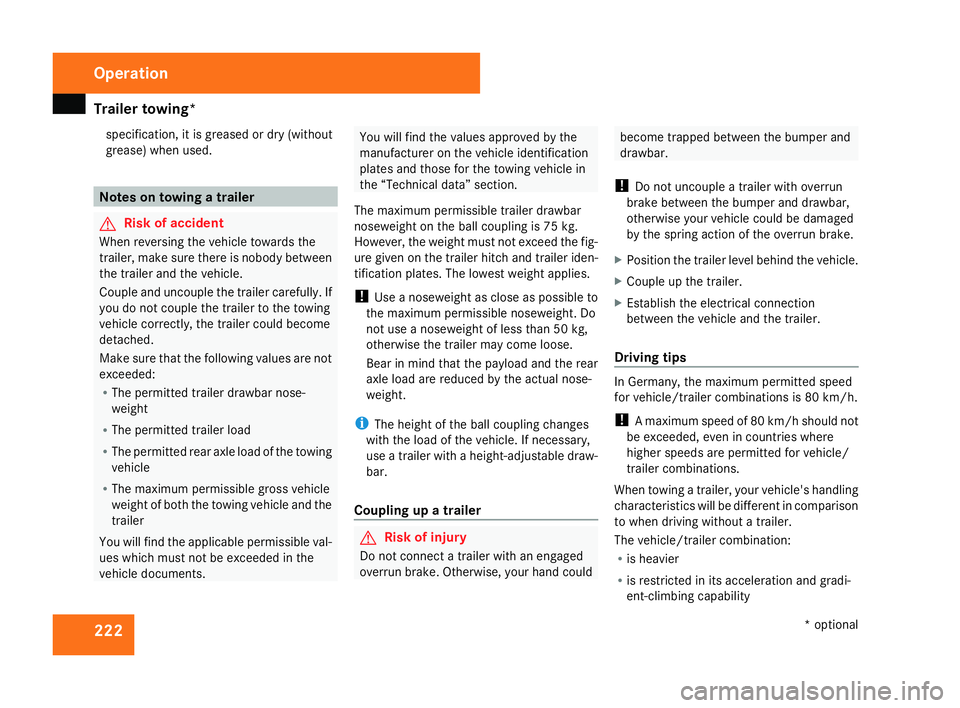
Trailer towing*
22
2
specification, it is greased or dry (without
grease) when used. Notes on towing a trailer
G
Risk of accident
When reversing the vehicle towards the
trailer, make sure there is nobody between
the trailer and the vehicle.
Couple and uncouple the trailer carefully. If
you do not couple the trailer to the towing
vehicle correctly, the trailer could become
detached .
Make sure that the following values are not
exceeded:
R The permitted trailer drawbar nose-
weight
R The permitted trailer load
R The permitted rear axle load of the towing
vehicle
R The maximum permissible gross vehicle
weight of both the towing vehicle and the
trailer
You will find the applicable permissible val-
ues which must not be exceeded in the
vehicle documents. You will find the values approved by the
manufacturer on the vehicle identification
plates and those for the towing vehicle in
the “Technical data” section.
The maximum permissible trailer drawbar
noseweight on the ball coupling is 75 kg.
However, the weight must not exceed the fig-
ure given on the trailer hitch and trailer iden-
tification plates. The lowest weight applies.
! Use a noseweight as close as possible to
the maximum permissible noseweight. Do
not use a noseweight of less than 50 kg,
otherwise the trailer may come loose.
Bear in mind that the payload and the rear
axle load are reduced by the actual nose-
weight.
i The height of the ball coupling changes
with the load of the vehicle. If necessary,
use a trailer with a height-adjustable draw-
bar.
Coupling up a trailer G
Risk of injury
Do not connect a trailer with an engaged
overrun brake. Otherwise, your hand could become trapped between the bumper and
drawbar.
! Do not uncouple a trailer with overru n
brake between the bumper and drawbar,
otherwise your vehicle could be damaged
by the spring action of the overrun brake.
X Position the trailer level behind the vehicle.
X Couple up the trailer .
X Establish the electrical connectio n
between the vehicle and the trailer.
Driving tip s In Germany, the maximum permitted speed
for vehicle/trailer combinations is 80 km/h.
!
A maximum speed of 80 km/h should not
be exceeded, even in countries where
higher speeds are permitted for vehicle /
trailer combinations.
When towing a trailer, your vehicle's handling
characteristics will be different in compariso n
to when driving without a trailer.
The vehicle/trailer combination:
R is heavier
R is restricted in its acceleration and gradi-
ent-climbing capabilit yOperation
* optional
204_AKB; 2; 3, en-GB
mkalafa,
2007-06-26T23:11:51+02:00 - Seite 222
Page 338 of 377
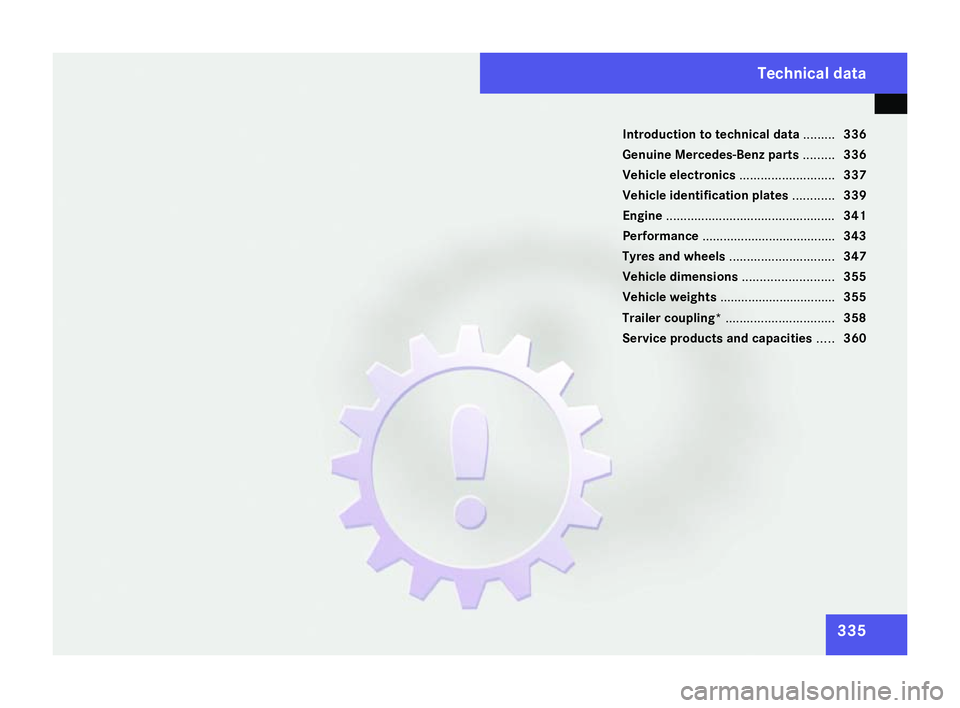
335
Introduction to technical data
.........336
Genuine Mercedes-Benz parts .........336
Vehicle electronics ...........................337
Vehicle identification plates ............339
Engine ................................................ 341
Performance ...................................... 343
Tyres and wheels .............................. 347
Vehicle dimensions ..........................355
Vehicle weights ................................. 355
Trailer coupling* ............................... 358
Service products and capacities .....360 Technical data
204_AKB; 2; 3, en-GB
mkalafa,
2007-06-26T23:11:51+02:00 - Seite 335
Page 339 of 377

Genuine Mercedes-Benz parts
336 Introduction to technical dat
a
i The technical data was determined in
accordance with EU directives. All data
applies to the vehicle's standard equip-
ment. The data may therefore differ for
vehicles with optional equipment. You can
obtain further information from a
Mercedes-Benz Service Centre. Genuine Mercedes-Benz parts
Mercedes-Benz tests genuine parts and con-
version parts and accessories which have
been specifically approved for your vehicle for
their reliability, safety and suitability.
Despite ongoing market research, Mercedes-
Benz is unable to evaluate other parts.
Mercedes-Benz therefore accepts no respon-
sibility for the use of such parts in Mercedes-
Benz vehicles, even if they have been
independently or officially approved.
In Germany and some other countries, certain
parts are only officially approved for installa-
tion or modification if they comply with legal
requirements. All genuine Mercedes-Ben z
parts meet this requirement.
Observe the suitability of replacement parts
for your vehicle. In many countries, certain
parts which result in a modification to the
vehicle could invalidate the vehicle's general
operating permit . This is the case if:
R
they cause a change of the vehicle typ e
from that for which the vehicle's genera l
operating permit was granted
R other road users could be endangered
R the emission or noise levels are adversely
affected
The use of non-approved parts could affec t
your vehicle's operating safety. Mercedes -
Benz therefore recommends genuine
Mercedes-Benz parts and conversion parts
and accessories that have been approved for
your vehicle . H
Environmental not
e
DaimlerChrysler also supplies recondi-
tioned assemblies and parts which are of
the same quality as new parts. For these ,
the same liability for material defects
applies as with new parts.
Genuine Mercedes-Benz parts and approved
conversion parts and accessories are availa -
ble from Mercedes-Benz Service Centres.
There, you can also receive advice about tech-
nical modifications and have the parts pro-
fessionally fitted.
Always quote the vehicle identification num-
ber and the engine number when orderin gTechni
cal data
204_AKB; 2; 3, en-GB
mkalafa
, 2007-06-26T23:11:51+02:00 - Seite 336
Page 340 of 377
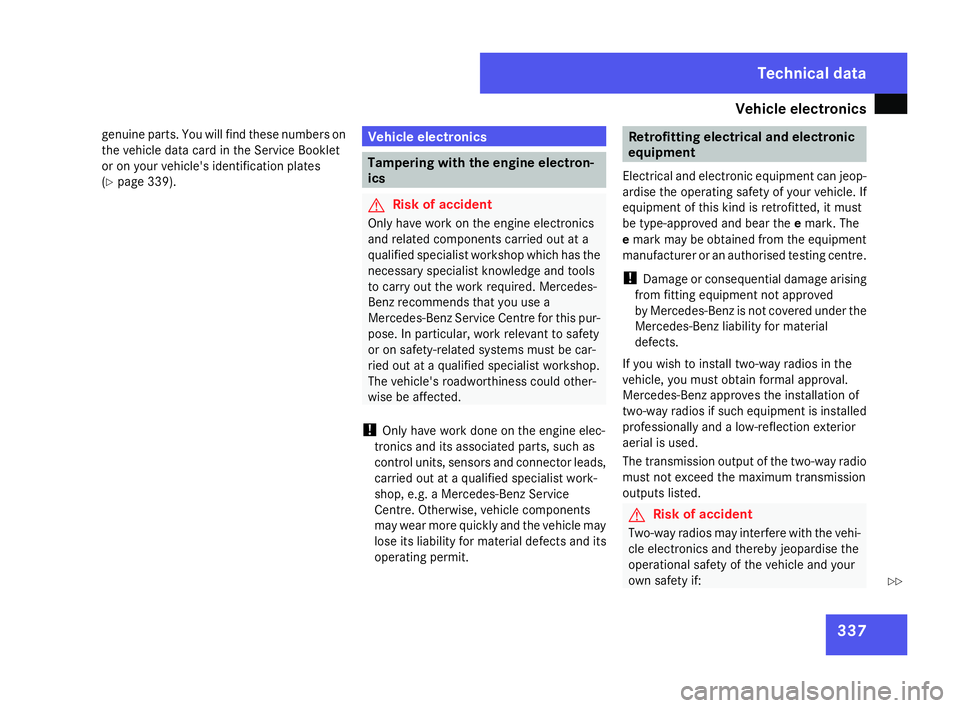
Vehicle electronic
s 337
genuine parts. You will find these numbers on
the vehicle data card in the Service Booklet
or on your vehicle's identification plates
( Y page 339). Vehicle electronics
Tampering with the engine electron-
ics
G
Risk of accident
Only have work on the engine electronics
and related components carried out at a
qualified specialist workshop which has the
necessary specialist knowledge and tools
to carry out the work required. Mercedes-
Benz recommends that you use a
Mercedes-Benz Service Centre for this pur-
pose. In particular, work relevant to safety
or on safety-related systems must be car-
ried out at a qualified specialist workshop.
The vehicle's roadworthiness could other-
wise be affected.
! Only have work done on the engine elec-
tronics and its associated parts, such as
control units, sensors and connector leads,
carried out at a qualified specialist work-
shop, e.g. a Mercedes-Benz Service
Centre. Otherwise, vehicle components
may wear more quickly and the vehicle may
lose its liability for material defects and its
operating permit. Retrofitting electrical and electronic
equipment
Electrical and electronic equipment can jeop-
ardise the operating safety of your vehicle. If
equipment of this kind is retrofitted, it must
be type-approved and bear the emark. The
e mark may be obtained from the equipment
manufacturer or an authorised testing centre.
! Damage or consequential damage arising
from fitting equipment not approved
by Mercedes-Benz is not covered under the
Mercedes-Benz liability for materia l
defects.
If you wish to install two-way radios in the
vehicle, you must obtain formal approval.
Mercedes-Benz approves the installation of
two-way radios if such equipment is installed
professionally and a low-reflection exterior
aerial is used.
The transmission output of the two-way radio
must not exceed the maximum transmission
outputs listed. G
Risk of accident
Two-way radios may interfere with the vehi-
cle electronics and thereby jeopardise the
operational safety of the vehicle and your
own safety if: Technical data
204_AKB; 2; 3, en-G
B
mkalafa , 2007-06-26T23:11:51+02:00 - Seite 337 Z
Page 343 of 377
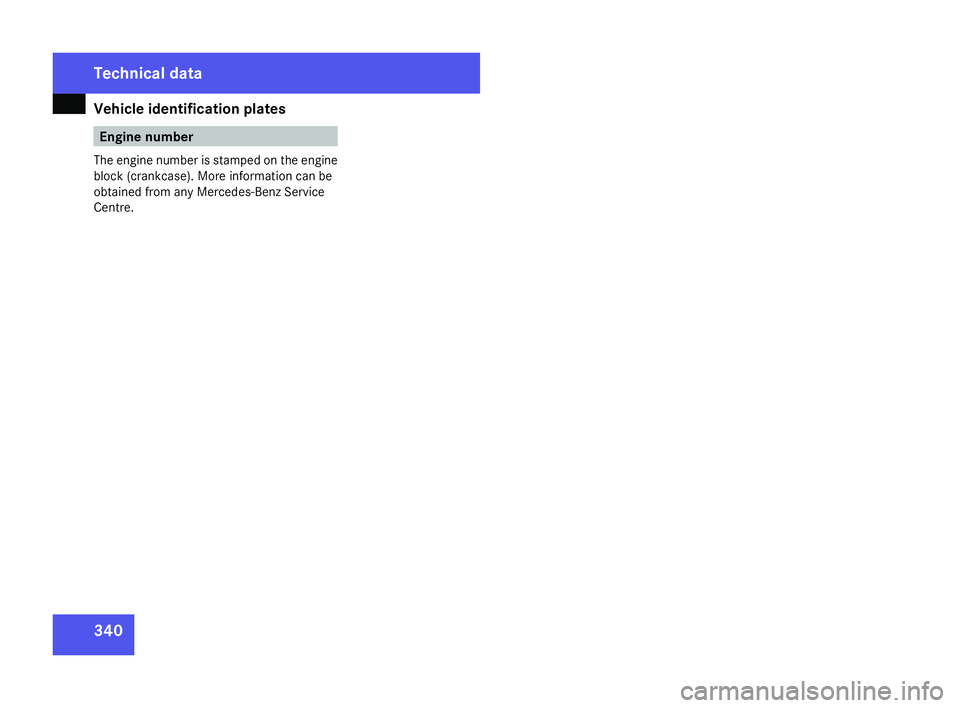
Vehicle identification plate
s340 Engine number
The engine number is stamped on the engin e
block (crankcase). More information can be
obtained from any Mercedes-Benz Service
Centre. Technical data
204_AKB; 2; 3, en-GB
mkalafa,
2007-06-26T23:11:51+02:00 - Seite 340
Page 344 of 377
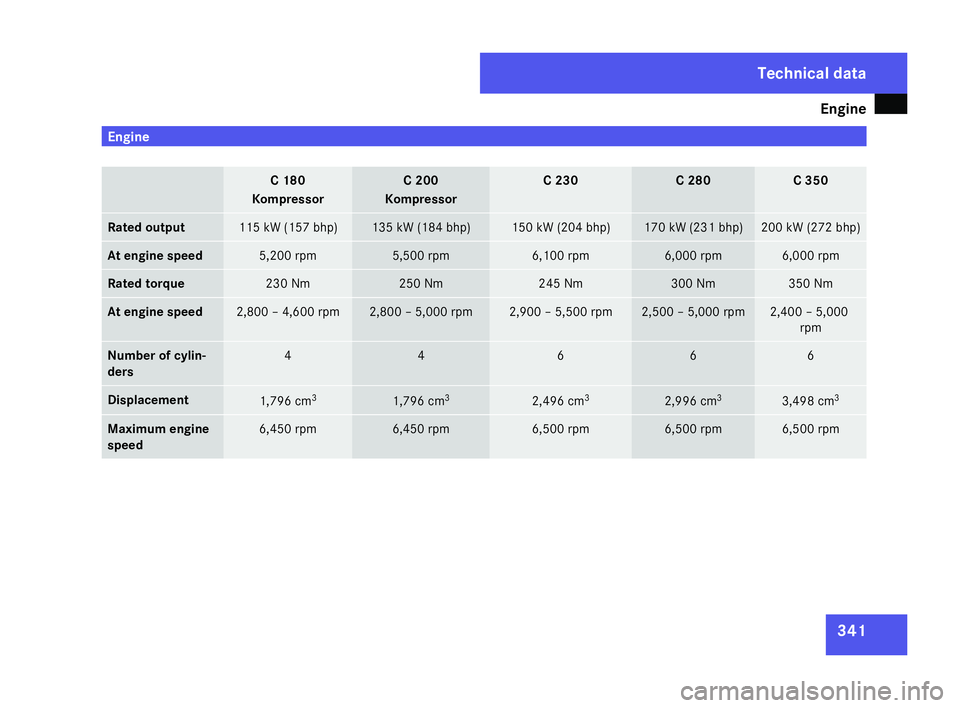
Engine
341Engine
C 180
Kompressor C 200
Kompressor C 230 C 280 C 350
Rated outpu
t 115 kW (157 bhp) 135 kW (184 bhp) 150 kW (204 bhp) 170 kW (231 bhp) 200 kW (272 bhp)
At engine spee
d 5,200 rpm 5,500 rpm 6,100 rpm 6,000 rpm 6,000 rpm
Rated torque 230 Nm 250 Nm 245 Nm 300 Nm 350 Nm
At engine spee
d 2,800 – 4,600 rpm 2,800 – 5,000 rpm 2,900 – 5,500 rpm 2,500 – 5,000 rpm 2,400 – 5,000
rpm Number of cylin-
ders 4 4 6 6 6
Displacement
1,796 cm
3 1,796 cm
3 2,496 cm
3 2,996 cm
3 3,498 cm
3 Maximum engine
spee
d 6,450 rpm 6,450 rpm 6,500 rpm 6,500 rpm 6,500 rpmTechnical data
204_AKB; 2; 3, en-GB
mkalafa,
2007-06-26T23:11:51+02:00 - Seite 341